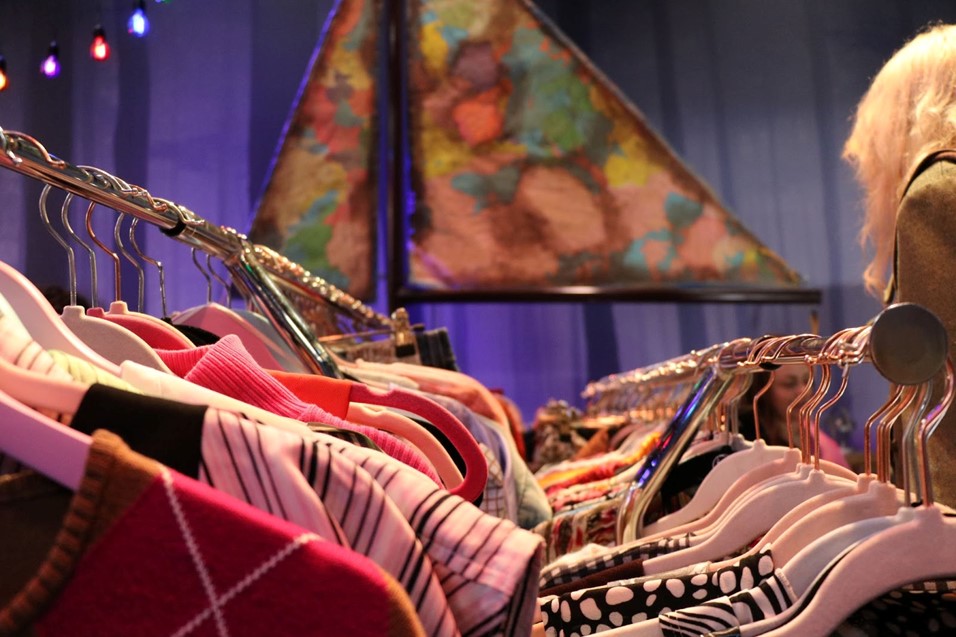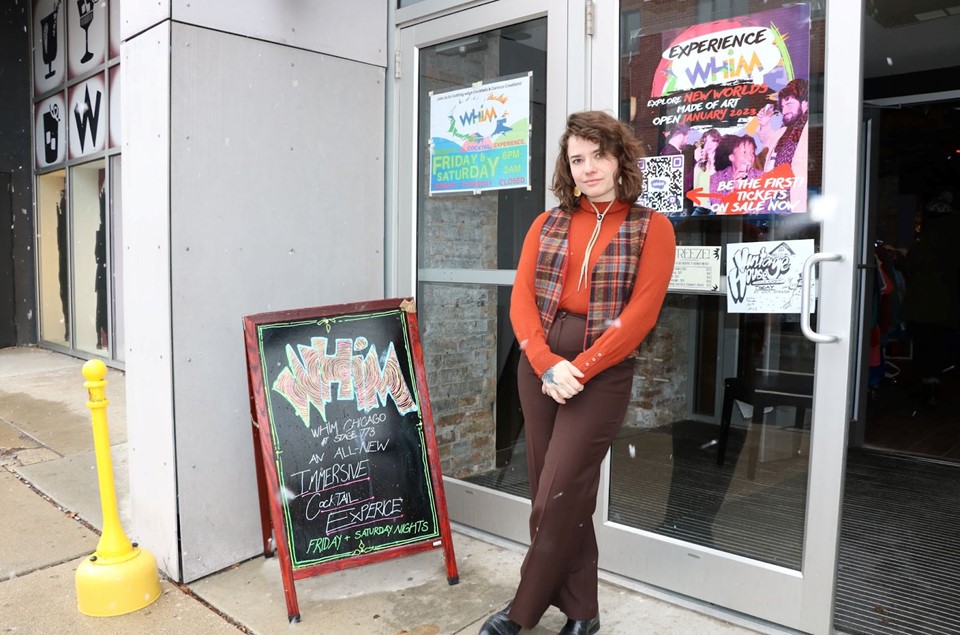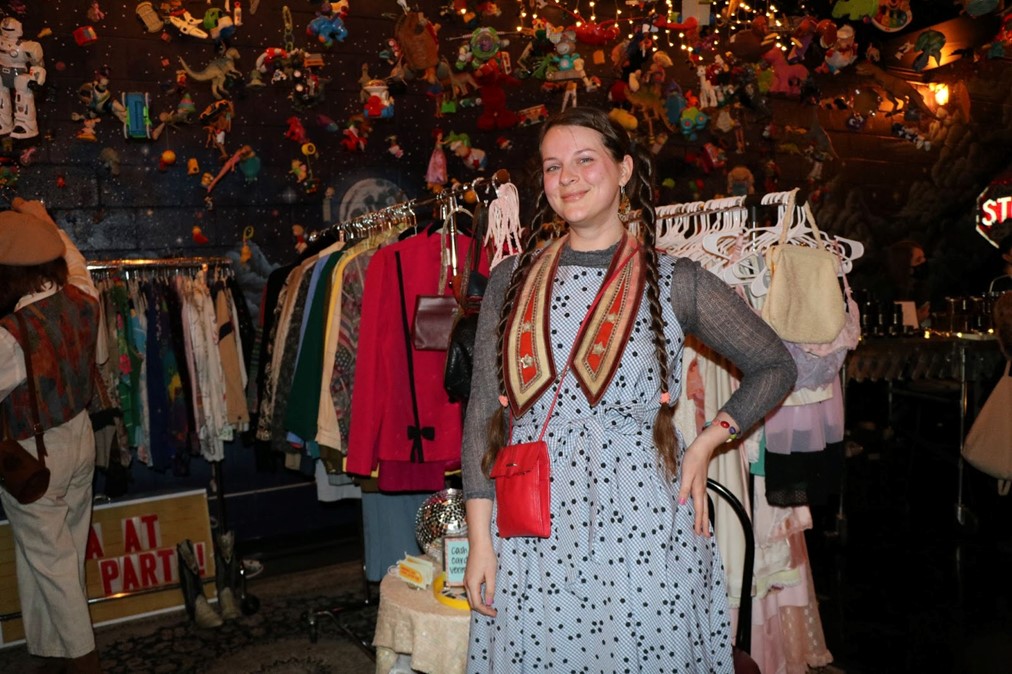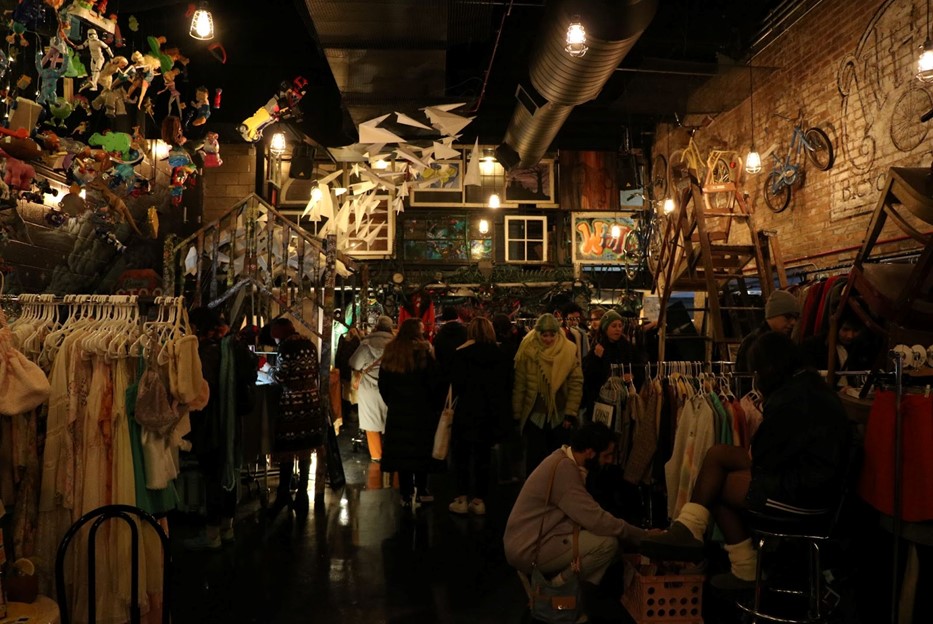Vintage curators and pop-up shops around the city have been producing a more ethical way to consume fashion, while providing community and sustainability to Chicago.

Rows of unique vintage clothing line the racks at the Vintage House Chicago pop-up. Photo by Hailey Bosek, 14 East.
In a venue space normally reserved for Whim, an immersive cocktail bar, a busy scene unfolded on a snowy January day. Inside, people in creased and weathered leather jackets wandered around as long skirts grazed the floor. Patrons with chunky sweaters reminiscent of the 80’s chatted with those who wore patterned blouses. The site was full of colored lighting while rock music blasted on the speakers. People of all ages filled the Vintage House Chicago pop-up shop to try to find new pieces to add to their collection.
Pop-Ups and Defining Vintage
When you enter a Vintage House Chicago pop-up, you’ll see all types of vendors. People selling lacy slip dresses, or those who specialize in leather coats and jackets, old World Series t-shirts, and even vintage boots. These eclectic pieces scattered throughout the venue are certainly interesting to look at, but what makes these things vintage?
It’s generally agreed upon by people like Maddie Rodgers, head of Vintage House Chicago, or Shayne Kelly, founder of Illinois Vintage Fest, that vintage is anything 20 years or older.

Rodgers poses outside of the Whim venue the day of the event. Photo by Hailey Bosek, 14 East.
Vintage House operates a bimonthly pop-up shop in different locations around the city. These pop-ups host a number of Midwestern vendors who sell their curated products. Rodgers also runs her own curated shop, Primary Vintage. She collects vintage items through various means.
“This job prior to participating in markets was a very isolating one, because you do everything alone,” Rodgers said. “When I started doing markets in 2020, I suddenly got to talk to people about clothes and share this mutual interest and love with people, and it really changed the game.”
There are a number of ways to participate in the buying of vintage, but the growing trend of pop-up shops have allowed for vendors and curators from all over to gather in one place. Each pop-up varies in vendors and venue space. Sunday’s event included extra vendors like soap makers and those who took advantage of the venue’s full-service bar with specialty cocktails for guests over 21.
Community in Vintage and the Appeal
At the center of the venue was the vendor Alma at the Party, a Bloomington, Illinois-based curator specializing in bold prints and colors. The owner, Texas native Sydney Snedeker, who was decked in a vintage plaid and polka-dot frock and braided pigtails, named her shop after her late grandmother, Alma.
“She was the type of person that always dressed for the occasion. She loved a theme and loved a party. And she liked to save everything, so I inherited her whole life’s collection of her stuff,” Snedeker said.
Armed with her passions for fashion and faith in sustainability, Snedeker has not bought a new item since 2018. She has been to many pop-ups over the years, with over 15 in 2022 alone. Snedeker said it is these events that fuel her passion for vintage even further.
“I always go home and tell my partner, these are definitely my people,” Snedeker said.

Snedeker poses in front of her collection for Alma at the Party. Photo by Hailey Bosek, 14 East.
Community can be a hard thing to define in the digital age. In what feels like only one of the thousands of lessons we have learned from the pandemic, it is clear that a community can thrive, even when separated from each other. However, in a return to what feels like normalcy, operating under the same roof can foster a strong sense of community.
Grace Kellison was browsing the pop-up shop on Sunday. She buys most of her clothes secondhand, as do most of the people she interacts with.
“I’m also in the art community and feel like a lot of my peers are very into secondhand but also events like this, pop-ups and stuff, reaffirm community and grow it,” Kellison said.
This reaffirmation of the vintage community keeps vendors, curators and patrons alike interacting with each other.
Kelly, who founded Illinois Vintage Fest, believes that the vintage community is more than just friends meeting up.
“When you love something so much, and I love vintage a lot—it saved my life, pretty much—you can’t help but connect to other people with it,” Kelly said.

Vendors sell their unique collections at the pop-up shop. Photos by Hailey Bosek, 14 East.
He explained how fostering a love for vintage in the community has allowed him to do some of the most gratifying work, like reconnecting pieces of clothing that previous family members had worn once in the distant past. The service of providing memories and nostalgia through apparel is one of the things that can make vintage more than just old clothes, but a look into the past.
The Values Behind Vintage
Consumers and curators alike are drawn to vintage for a variety of reasons. The vintage market has exploded over the past five years, which has increased the secondhand market. According to OfferUp’s 2022 recommerce report, recommerce has grown by 15% in 2021, which is twice as fast as the normal consumer market. It seems that through the conversations at the pop-up, the appeal for most vintage connoisseurs is placed in a value system. There is an ethical and aesthetic appeal to vintage that allows many people to participate within fashion in a new way.
The aversion to fast fashion is a positive reflection of the increased awareness of the environmental strain the fast-fashion industry has on the environment. The decrease of price and quality has made the want and need for consumption even more widespread. According to Earth.Org, the fashion industry comprises 10% of the entire global carbon emissions.
When shopping, Kellison admitted that she feels like she has a moral obligation to not consume too much fast fashion.
“I feel guilty if I buy stuff that’s fast fashion, and I know I’m not gonna be wearing it all the time,” Kellison said. She feels that buying secondhand and vintage relieves her conscience when buying something new.

Patrons browse all the apparel the curators have to offer. Photos by Hailey Bosek, 14 East.
Nonetheless, there are still ethical concerns when shopping vintage. Rodgers confided how the community was affected by things like price gouging, or the practice of purposely pricing vintage things at incredibly high rates. This can end up isolating people with lower incomes from engaging in vintage. The vendors all explained how critiques of curators are abundant. Many feel that curators pick out things that people who need them more would want, and then sell them for a huge profit. Rodgers explained that this is a huge contention concerning people in the vintage community. However, vendors feel that they spend their time picking out hidden gems that might have been thrown away had they not been there. They feel that the hours spent picking through the bins to find items that matched their niches have value.
“It also gets tricky because assigning worth/value to an item is really difficult. How much do you pay yourself for your expertise in sorting? For your knowledge that you should select that item because it’s valuable? How much does age add value to an item?” Rodgers said.
“Resellers are curators and I think it’s a valuable service, because so many clothes end up in the landfill. I think the concept that resellers should leave something behind because someone who would use it might find it is just too vague and finicky. What if they don’t and that piece just ends up in the trash?” Rodgers said.
Snedeker also expressed that she felt her job as a reseller and the time spent curating and selling has fiscal value. She expressed that there are enough clothes in the world; you just have to find the ones right for you.
“Being in this industry, you realize that fashion is cyclical. Trends always come around. Everything you want, it already exists in the world. It takes some time to find it occasionally,” Snedeker said.
Snedeker feels that the time she saves people from finding the perfect item is where the value of her work lies.
“That’s where I kind of squeezed myself in. Not everybody has the time to, like, thrift through every rack ever. So I tried to pick out things that I think are special or that people will like,” Snedeker said.
While the price gouging debate can be heated, Sunday’s vendors had unique and interesting pieces that were priced as low as $5. Despite many vendors trying their best to keep pop-up shops an ethical place to consume vintage, problems will always occur.
“While doing resale is a nontraditional job, it still ultimately functions under capitalism and is not without its flaws,” Rodgers said.

The main room at the Whim venue space is bustling with patrons and vendors. Photo by Hailey Bosek, 14 East.
Just Browsing
The choice to sift through the racks of Goodwill, or buy a curated and approved vintage item is up to you. However you pursue vintage, it doesn’t seem like people in this community would judge. Every style imaginable filled the Whim venue space. It didn’t matter if you were wearing your approved vintage Tom Ford, or a brand new North Face coat. Everyone was welcomed to stop in and appreciate the eccentric and captivating collections.
Header Illustration by Magda Wilhem




NO COMMENT